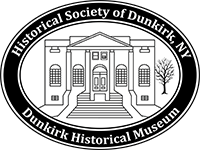With the arrival of the railroad to Dunkirk in 1851 and with easy access due to its harbor, by the 1860’s the city’s industry grew and diversified. By 1887 the city’s five railroad lines readily connected it to places east and west as well as south toward Pittsburgh. The Brooks Locomotive Works was established in 1869, so that industry seemed centered on the railroad and its supplies.
However, an 1894 pamphlet called Dunkirk and Its Possiblities stated that Dunkirk had “56 manufactories,” factory sites where diverse goods were being manufactured. The same pamphlet noted that an “industrial investment” of $2,810,000″ had been made in the city, revealing the strength of that diversity. Some 2,800 people were employed at manufacturing plants in a population of about 12,000. The state census of 1915 reported that all factories of the city employed 4,350 in a population of about 18,000. These numbers dropped during the Depression, then rose again especially as the country moved toward involvement in World War II. The influx of immigrants eager to work at hard industrial jobs and the presence of railroad transportation and shipping inspired industry to grow.
The city’s industries made crucial contributions to the efforts of both world wars. ALCO made bombs for the British army in World War I and heavy artillery guns for the American army in World War II. The defense department constructed one of the main buildings at Allegheny Ludlum so it could produce war material. Dunkirk Radiator also produced armaments in the early 1940’s, assembling hand grenades, bomb noses, and land mines.
